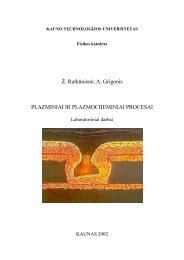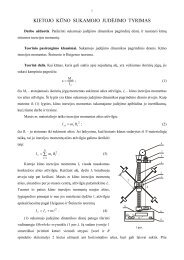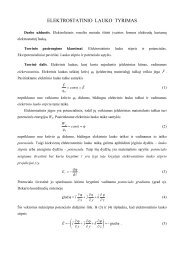PROCEEDINGS OF THE 7 INTERNATIONAL ... - Fizika
PROCEEDINGS OF THE 7 INTERNATIONAL ... - Fizika
PROCEEDINGS OF THE 7 INTERNATIONAL ... - Fizika
Create successful ePaper yourself
Turn your PDF publications into a flip-book with our unique Google optimized e-Paper software.
S. Bernhardsson et al. / Medical Physics in the Baltic States 7 (2009) 65 - 68<br />
n ⎛ S ⎞ i<br />
∑ i=<br />
⎜<br />
m ⎟ 1<br />
i<br />
OSL<br />
⎝ ⎠<br />
sample =<br />
(1)<br />
n<br />
where Si is the integrated signal, in the beginning of the<br />
stimulation, from aliquot i with mass mi and n is the<br />
number of aliquots (normally n = 5). Similarly, an OSL<br />
background, OSLbkg (counts mg -1 ) was estimated as the<br />
integrated signal during the late phase of the stimulation<br />
time. The absorbed dose, Dsample (mGy), to the salt was<br />
thereafter estimated by applying a calibration<br />
coefficient, cspecific (counts mGy -1 mg -1 ) to the net signal:<br />
specific<br />
( OSL OSL )<br />
1<br />
Dsample = ⋅ sample −<br />
c<br />
bkg<br />
(2)<br />
Details on the read out protocol and on the calibration<br />
coefficients are described in more detail by<br />
Bernhardsson et al. [5] and in [6].<br />
2.1 Occupational and medical exposures<br />
To test salt as a personal dosemeter and at different<br />
photon energies, four staff members working in the<br />
radiology and nuclear medicine departments at Malmö<br />
University Hospital (UMAS) carried the dosemeter kits<br />
during one month. The salt used for the personal<br />
dosemeters was Falksalt fint havssalt (Hansson and<br />
Möhring, Halmstad, Sweden), a naturally fine grained<br />
sea salt consisting of NaCl≥99.6%. The kits were<br />
attached to the investigated persons regular TLD (LiF:<br />
Mg, Ti) and the TL-readings from these were used for<br />
the NaCl/LiF comparison. Similar dosemeter kits were<br />
also attached to TLDs that were positioned on the inside<br />
walls of a nuclear medicine investigation room. A few<br />
other dosemeter kits were placed in the primary<br />
radiation field from a mammography X-ray unit and in<br />
the primary beam of a 60 Co therapy unit. At the 60 Co<br />
unit the dosemeter were given eight successively<br />
increasing doses in the range from 1.4 mGy to 4.1 Gy.<br />
2.2 Environmental exposure<br />
To test the salt (Falksalt fint bergsalt, Hansson and<br />
Möhring, Halmstad, Sweden) during normal<br />
environmental conditions, dosemeter kits were<br />
positioned in a highly 137 Cs-contaminated village in<br />
Belarus, during the summer of 2008. Between 5 and 14<br />
kits were attached to the inside- and outside walls of<br />
each one of the 7 houses included in the study. After 2.5<br />
months the dosemeters were re-collected and brought<br />
back to Sweden for the read-out. During the distribution<br />
and collection of the dosemeters a special radiation<br />
protection instrument, GR-110 (NaI(Tl)-detector;<br />
Exploranium, Canada) was used to directly determine<br />
the dose rate in situ. A mean value from these<br />
measurements was used to include the GR-110 readings<br />
in the comparison between NaCl and LiF.<br />
A few TLDs and direct measurements, using various<br />
radiation protection instruments (e.g. SRV-2000;<br />
RADOS, Finland), were used during transport and<br />
66<br />
storage to estimate the dose accumulated when the<br />
dosemeters were not in position in the village.<br />
3. Results and discussion<br />
3.1. Occupational and medical exposures<br />
The relation between the OSL-signal in NaCl and the<br />
absorbed dose as measured by LiF for measurements on<br />
the personnel in diagnostic radiology and nuclear<br />
medicine as well as in the primary beam of a<br />
mammography X-ray unit is shown in: Fig. 1. The same<br />
relation is also shown for similar measurements in a<br />
60<br />
Co beam. At low photon energies (mammography),<br />
the OSL-measurements indicate a somewhat higher<br />
response relative to the LiF-TL dosemeters. The effect<br />
may be attributed to the somewhat higher atomic<br />
number of NaCl (Z = 11; 17) compared to LiF (Z = 3;<br />
9).<br />
Fig. 1. The OSL signal from NaCl as a function of absorbed<br />
dose measured by LiF (TLD) for ten “twin” dosemeter kits<br />
(OSL and TL) positioned at the following locations; i.) on<br />
individual staff members in diagnostic radiology (no 1 and 2),<br />
ii.) on individuals at the nuclear medicine department (no 3<br />
and 4), iii.) in the mammography primary radiation field (no 5<br />
and 6), iv.) on the interior walls of a nuclear medicine<br />
laboratory (no 7). The OSL response vs. absorbed dose<br />
determined by LiF-TL dosemeters placed in a 60 Co beam is<br />
shown for comparison (no 8).<br />
Although these results are based on a small number of<br />
NaCl/LiF dosemeters, the salt shows a similar dose<br />
response at different photon energies, compared to<br />
ordinary TLDs.<br />
3.2. Environmental exposure<br />
The total absorbed dose accumulated under fieldconditions<br />
in the Belarusian village, between resetting<br />
of the luminescence and the read-out in Sweden, is<br />
presented in: Fig. 2. The absorbed dose to 54 dosemeter<br />
kits as determined by OSL in NaCl is plotted as a<br />
function of the corresponding value for TL in LiF. In<br />
view of the low signals there is a fairly good correlation<br />
(r 2 = 0.55) between the two types of dosemeters. There<br />
is however a systematic difference, where the NaCl<br />
dosemeters on average, show a 0.16 mGy higher<br />
absorbed dose compared with the TLDs. This might








